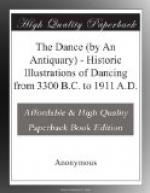The earliest accompaniments to dancing appear to have been the clapping of hands, the pipes,[Footnote: Egyptian music appears to have been of a complicated character and the double pipe or flutes were probably reeded, as with our clarionet. The left pipe had few stops and served as a sort of hautboy; the right had many stops and was higher. The single pipe, (a) “The recorder” in the British Museum, is a treble of 10-1/2 in. and is pentaphonic, like the Scotch scale; the tenor (b) is 8-3/4 in. long and its present pitch—[Illustration: a] [Illustration: b] the guitar, the tambourine, the castanets, the cymbals, the tambour, and sometimes in the street, the drum.
The following account of Egyptian dancing is from Sir Gardiner Wilkinson’s “Ancient Egypt” [Footnote: Vol. i., p. 503-8.]:—
“The dance consisted mostly of a succession of figures, in which the performers endeavoured to exhibit a great variety of gesture. Men and women danced at the same time, or in separate parties, but the latter were generally preferred for their superior grace and elegance. Some danced to slow airs, adapted to the style of their movement; the attitudes they assumed frequently partook of a grace not unworthy of the Greeks; and some credit is due to the skill of the artist who represented the subject, which excites additional interest from its being in one of the oldest tombs of Thebes (B.C. 1450, Amenophis II.). Others preferred a lively step, regulated by an appropriate tune; and men sometimes danced with great spirit, bounding from the ground, more in the manner of Europeans than of Eastern people. On these occasions the music was not always composed of many instruments, and here we find only the cylindrical maces and a woman snapping her fingers in the time, in lieu of cymbals or castanets.
“Graceful attitudes and gesticulations were the general style of their dance, but, as in all other countries, the taste of the performance varied according to the rank of the person by whom they were employed, or their own skill, and the dance at the house of a priest differed from that among the uncouth peasantry, etc.
“It was not customary for the upper orders of Egyptians to indulge in this amusement, either in public or private assemblies, and none appear to have practised it but the lower ranks of society, and those who gained their livelihood by attending festive meetings.
“Fearing lest it should corrupt the manners of a people naturally lively and fond of gaiety, and deeming it neither a necessary part of education nor becoming a person of sober habits, the Egyptians forbade those of the higher classes to learn it as an amusement.
“Many of these postures resembled those of the modern ballet, and the pirouette delighted an Egyptian party 3,500 years ago.
“The dresses of the females were light and of the finest texture, a loose flowing robe reaching to the ankles, sometimes with a girdle.




